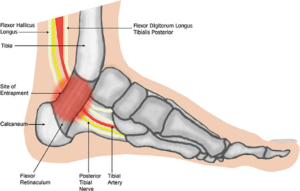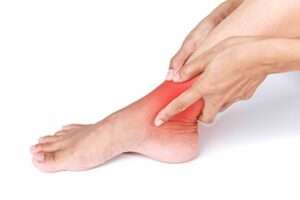Tarsal Tunnel Syndrome
What is Tarsal Tunnel Syndrome?
Tarsal Tunnel Syndrome is a condition where the posterior tibial nerve, which runs along the inside of your ankle and foot, becomes compressed or trapped. The posterior tibial nerve passes through a narrow passage known as the tarsal tunnel, located on the inside of your ankle. When this tunnel narrows, it puts pressure on the nerve, causing pain, tingling, numbness, and other uncomfortable sensations along the foot and ankle.

Causes of Tarsal Tunnel Syndrome
Tarsal Tunnel Syndrome can develop due to a variety of causes:
- Ankle injuries or trauma that lead to swelling, putting pressure on the nerve.
- Cysts or bone spurs that form within the tunnel, causing compression of the nerve.
- Foot posture issues, like flat feet, that increase pressure in the tarsal tunnel.
- Sports activities that strain or pressure the ankle structures.
- Medical conditions like arthritis, which can inflame the ankle joints and narrow the tunnel.
- In some cases, no specific cause can be identified.
People with flat feet or high arches are particularly at risk due to the altered mechanics in the foot and ankle that contribute to nerve compression.
Symptoms of Tarsal Tunnel Syndrome
Tarsal Tunnel Syndrome typically produces a range of painful and uncomfortable symptoms, including:
- Pain along the inside of the ankle and the bottom of the foot
- Burning or tingling sensations
- Pins and needles or numbness, especially in the heel or arch
- Increased discomfort when standing, walking, or putting pressure on the foot
The severity of the symptoms can vary depending on foot and ankle position, as this can alter the space in the tarsal tunnel.

Treating Tarsal Tunnel Syndrome
First Steps for Managing Tarsal Tunnel Syndrome
- Rest and avoid activities that worsen symptoms, such as standing or walking for long periods.
- Ice and elevation can reduce swelling, which may help relieve some pain and discomfort.
- Anti-inflammatory medications like Ibuprofen can be useful for reducing inflammation and pain.
Professional Care at Leading Health Podiatry
A thorough evaluation from your podiatrist is essential to determine the cause of your Tarsal Tunnel Syndrome and to prevent long-term nerve damage. At Leading Health Podiatry, our approach includes:
- Biomechanical assessments to understand the root cause of nerve compression.
- Custom foot orthotics to improve alignment, reduce pressure, and promote healing in the tarsal tunnel.
- Swelling management and treatment for injuries contributing to nerve compression.
- Footwear advice to support your recovery and avoid aggravating the condition.
- Once symptoms improve, we may introduce stretching, strengthening, or gait retraining programs to restore proper movement patterns.
In cases where cysts, bone spurs, or other growths are involved, we may recommend further intervention, including surgery, to relieve nerve compression.
If you’re experiencing symptoms of Tarsal Tunnel Syndrome, contact Leading Health Podiatry today for an accurate diagnosis and tailored treatment plan to address the issue and prevent future complications.
